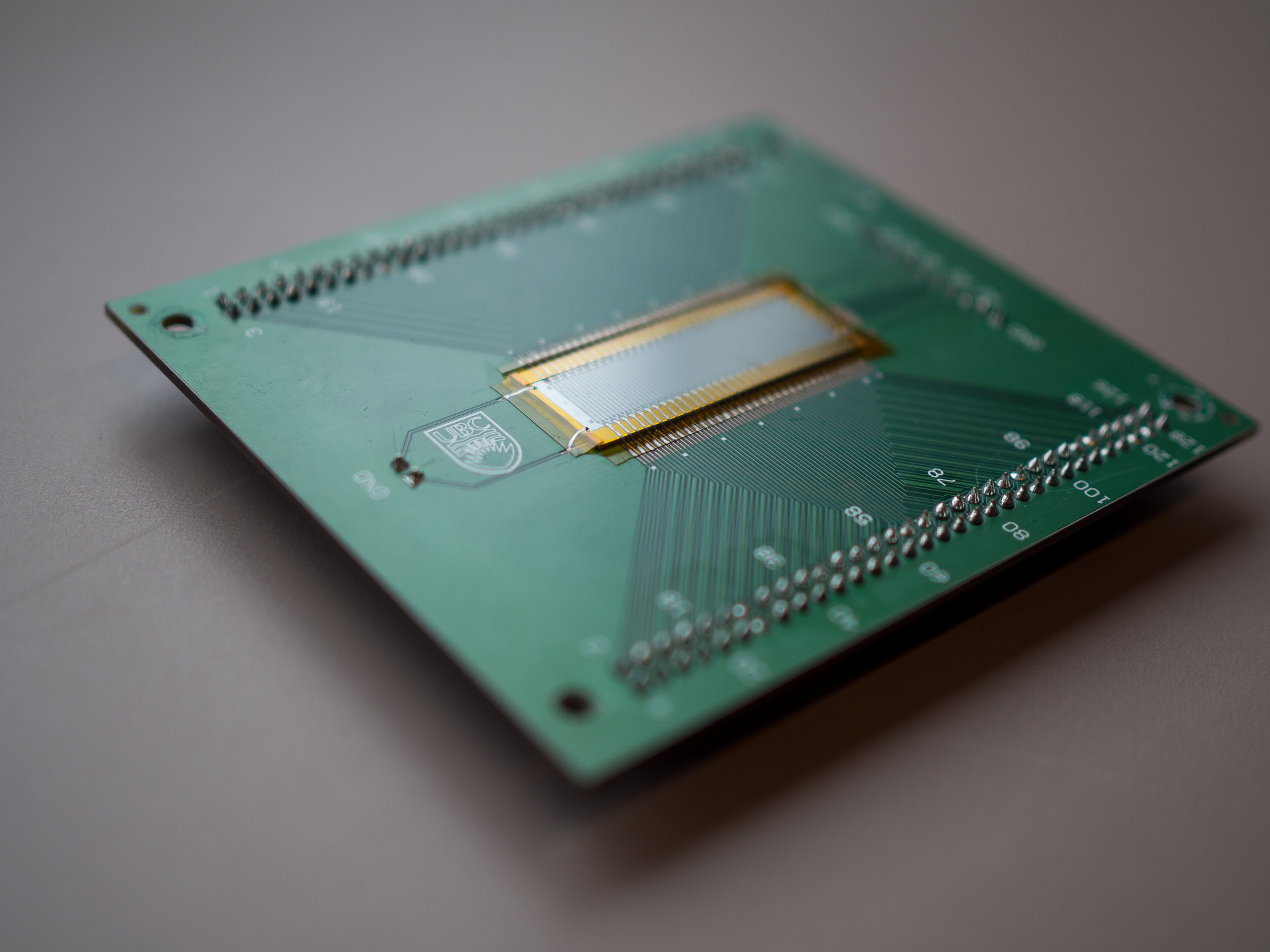
Photo by Clare Kiernan
At first glance, Carlos D. Gerardo, Edmond Cretu and Robert Rohling’s new polymer capacitive micro-machined ultrasound transducer (polyCMUT) looks like a computer chip, but it’s actually a series of microscopic drums built with a novel printing process. This innovation uses mechatronics and micromachining to convert sound into electrical signals at a fraction of the price of the industry-standard piezoelectric crystal technology.
The same technology used in a record player, piezoelectric ultrasound transducers depend on crystals that create a charge when they are squeezed, or change shape when a charge is passed through them. This is how they can convert the mechanical energy of sound waves into electrical signals. The drawback is that the crystal transducers are fragile, expensive and labour-intensive to produce – crystals are cut and arranged by hand, “like jewelry,” explains Dr. Robert Rohling, a Professor of both Mechanical Engineering and Electrical and Computer Engineering, and the director of UBC’s Institute for Computing, Information and Cognitive Systems (ICICS). On the other hand, Gerardo, Cretu and Rohling’s polyCMUTs act like moving capacitors – metal plates at the top and bottom of the drums allow for the measurement of electrical voltage between them as they vibrate. This is what allows information to pass from electrical signals to motion to sound and back again. Made of a polymer resin, they can be printed on demand, opening up the doors for automated mass production, as well as radical financial accessibility.
Dr. Rohling explained that the idea to use drums is not new; researchers at Stanford and other institutions have been looking into Capacitive Micromachine Ultrasound Transducers (CMUTs) as well. The UBC team’s difference is their focus on the material properties of the drums; using a flexible polymer allows them to be printed, and opens up a host of potential benefits and possibilities for customization. The decision to use a polymer that could be printed came about in part because of Cretu (ECE and ICICS Professor) and Rohling’s frustration with outsourcing prototype manufacturing. Having to send computer-generated designs off campus and wait for fabrication took too long to fit into the timelines needed by graduate students working on their research. With the idea to bring fabrication on site, the two professors co-supervised Gerardo, a Ph.D. candidate who brought in the printing element to their project. “Seven generations of devices later we said ‘eureka’,” explains Rohling.
Gerardo has recently defended his thesis, and the team is looking at what the year ahead will bring for their new technology. If Gerardo stays at UBC for a Postdoctoral Fellowship, he will spend the next year testing and prototyping the polyCMUTs, and formulating the plan with Entrepreneurship UBC to take them from the lab to the market, utilizing UBC’s Lean Launchpad and exploring industry collaborations.
Rohling’s plans are even larger: “This breakthrough is part of a much bigger vision we have for the whole field of ultrasound,” he says. Researchers are looking at ways to create highly portable devices that work with smartphones, making ultrasound machines “no longer on a big cart, but in the pocket of a doctor walking around the emergency room.” He and his colleagues are finding ways to lower the cost of ultrasound technology, provide greater access, identify new applications, and create new intelligence tools: new quantifying measures, artificial intelligence integrations, and ways of connecting ultrasound data to other information gathered from different sources. Rohling says:
If you look at how our healthcare system is going, we have a terrific health care system in Canada, but it has a lot of demand on it, and as Canadians age we have a big boom of baby boomers who are going to put even more pressure on the healthcare system. We need solutions that are going to provide expanded ability and at the same time it has to be at a lower cost.
PolyCMUTs are just one example of how interdisciplinary research is having an impact on our future. Their application is biomedical, their implementation is mechanical, and their realization took electrical and computer engineering. For Mechanical Engineering students interested in this area, Rohling recommends learning about mechatronics, but also lists a variety of mechanical engineering subjects involved in ultrasound research: from biomedical engineering to acoustics, to dynamics, mechanics, materials and beyond. There are many ways for Mechanical Engineering students to find their way into the fertile field of ultrasound and work on technologies that improve our health and wellbeing.
Read Gerardo, Cretu and Rohling’s paper on the development of polyCMUTs in Nature Microsystems & Nanoengineering.